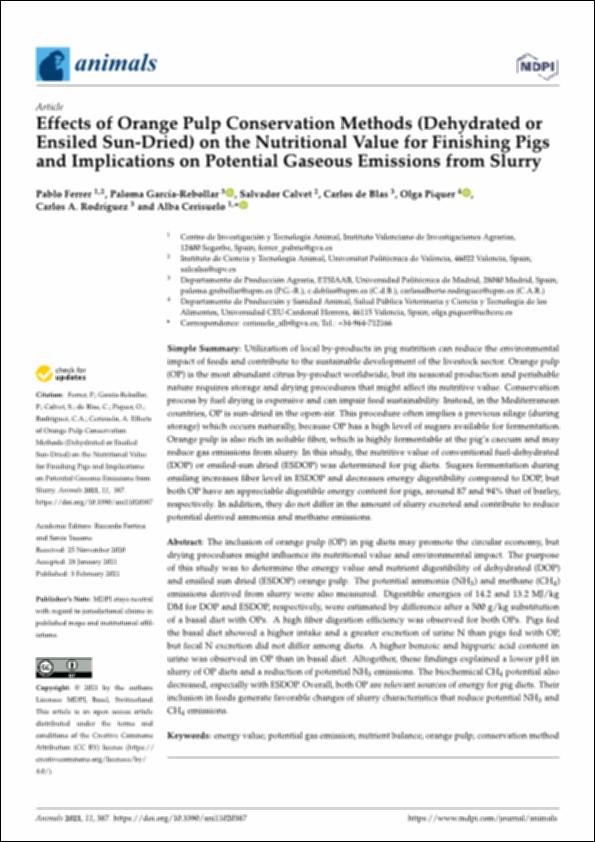Por favor, use este identificador para citar o enlazar este ítem:
http://hdl.handle.net/10637/13554Effects of orange pulp conservation methods (Dehydrated or Ensiled Sun-Dried) on the nutritional value for finishing pigs and implications on potential gaseous emissions from slurry
| Título : | Effects of orange pulp conservation methods (Dehydrated or Ensiled Sun-Dried) on the nutritional value for finishing pigs and implications on potential gaseous emissions from slurry |
| Autor : | Ferrer Riera, Pablo García Rebollar, Paloma Calvet Sanz, Salvador Blas, Carlos de Piquer Querol, Olga Rodríguez, Carlos A. Cerisuelo García, Alba |
| Materias: | Cerdos - Alimentación.; Swine - Feeding and feeds.; Oranges in nutrition.; Nutrición animal.; Lodos - Contaminación.; Mud pollution.; Naranjas - Valor nutritivo.; Animal nutrition. |
| Editorial : | MDPI |
| Citación : | Ferrer, P., García-Rebollar, P., Calvet, S., de Blas, C., Piquer, O., Rodríguez, C. A. & Cerisuelo, A. (2021). Effects of orange pulp conservation methods (Dehydrated or Ensiled Sun-Dried) on the nutritional value for finishing pigs and implications on potential gaseous emissions from slurry. Animals, vol. 11, i. 2 (03 feb.), art. 387. DOI: https://doi.org/10.3390/ani11020387 |
| Resumen : | The inclusion of orange pulp (OP) in pig diets may promote the circular economy, but drying procedures might influence its nutritional value and environmental impact. The purpose of this study was to determine the energy value and nutrient digestibility of dehydrated (DOP) and ensiled sun dried (ESDOP) orange pulp. The potential ammonia (NH3) and methane (CH4) emissions derived from slurry were also measured. Digestible energies of 14.2 and 13.2 MJ/kg DM for DOP and ESDOP, respectively, were estimated by difference after a 500 g/kg substitution of a basal diet with OPs. A high fiber digestion efficiency was observed for both OPs. Pigs fed the basal diet showed a higher intake and a greater excretion of urine N than pigs fed with OP, but fecal N excretion did not differ among diets. A higher benzoic and hippuric acid content in urine was observed in OP than in basal diet. Altogether, these findings explained a lower pH in slurry of OP diets and a reduction of potential NH3 emissions. The biochemical CH4 potential also decreased, especially with ESDOP. Overall, both OP are relevant sources of energy for pig diets. Their inclusion in feeds generate favorable changes of slurry characteristics that reduce potential NH3 and CH4 emissions. |
| Descripción : | Este artículo se encuentra disponible en la siguiente URL: https://www.mdpi.com/2076-2615/11/2/387 Este artículo pertenece al número especial "Green Feeds and Byproducts". |
| URI : | http://hdl.handle.net/10637/13554 |
| Derechos: | http://creativecommons.org/licenses/by/4.0/deed.es |
| ISSN : | 2076-2615 (Electrónico) |
| Fecha de publicación : | 3-feb-2021 |
| Centro : | Universidad Cardenal Herrera-CEU |
| Aparece en las colecciones: | Dpto. Producción y Sanidad Animal, Salud Pública Veterinaria y Ciencia y Tecnología de los Alimentos |
Los ítems de DSpace están protegidos por copyright, con todos los derechos reservados, a menos que se indique lo contrario.


